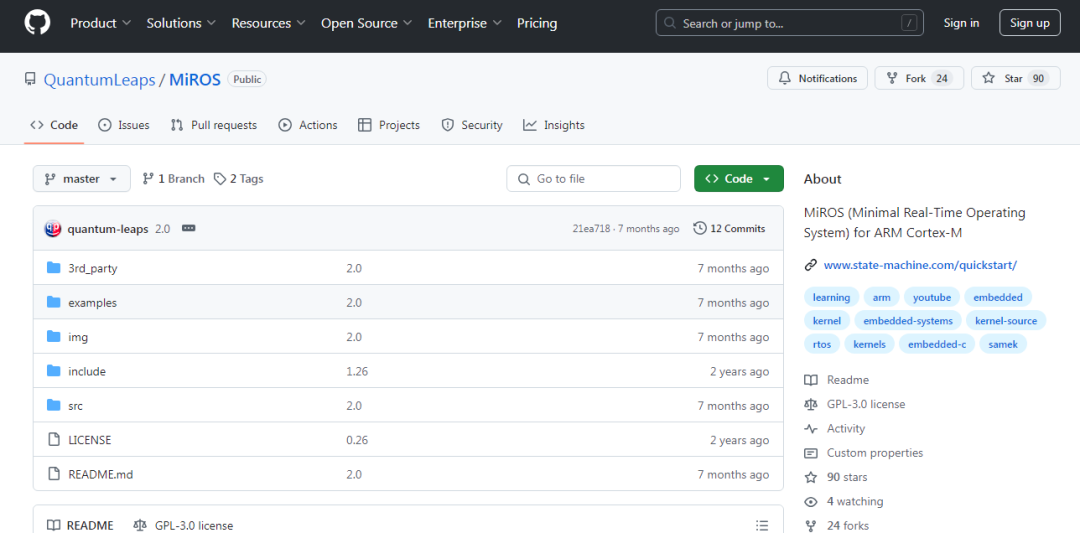In embedded system development, real-time operating systems (RTOS) play a crucial role, especially in applications that require high responsiveness and time determinism. MiROS (Minimal Real-Time Operating System) is a minimalist real-time operating system kernel designed specifically for ARM Cortex-M series microcontrollers, aimed at helping developers understand the basic concepts of RTOS.

Overview of MiROS
MiROS is a real-time operating system kernel that conforms to RMA (Rate-Monotonic Analysis) and RMS (Rate-Monotonic Scheduling) standards. It supports preemptive multi-thread priority scheduling, making it particularly suitable for teaching and learning the fundamentals of RTOS. The developers of MiROS aim to reduce its complexity and simplify the concepts involved, avoiding complex topics such as various edge cases, portability, or error handling. This design makes MiROS less suitable for commercial applications but very appropriate as a learning and teaching tool.
Features
-
• Priority Scheduling: Supports priority-based task scheduling, allowing developers to manage the execution order of different tasks. -
• Multi-Thread Support: Supports preemptive multi-threading, allowing multiple tasks to run in parallel and effectively utilize processing resources. -
• Simplified Design: Conceptually simplifies the architecture of RTOS, providing learners with a clear understanding. -
• Support for Multiple Toolchains: MiROS is compatible with various embedded development toolchains, including ARM/KEIL MDK, GNU-ARM (Makefile projects), and IAR EWARM.
Supported Platforms for MiROS
MiROS provides support for various embedded development boards, facilitating developers to apply and test in different environments. For example:
-
• EK-TM4C123GXL (TivaC LaunchPad, ARM Cortex-M4F) -
• STM32 NUCLEO-L152RE (ARM Cortex-M3) -
• STM32 NUCLEO-C031C6 (ARM Cortex-M0+)
Project Structure and File Description
The MiROS project file structure is clear and mainly includes the following directories:
-
• **3rd_party/**: Includes necessary third-party software support, such as ARM CMSIS and low-level code for specific development boards. -
• **examples/**: Provides example projects for each supported board, such as the Blinky program. -
• **include/**: Contains MiROS API header files. -
• **src/**: Stores the source code of MiROS, with different implementations based on different toolchains.
Building and Running Examples
MiROS provides an example program named “Blinky” to help developers get started quickly. In the examples directory, select the Blinky example for the corresponding development board, then navigate to the appropriate subdirectory based on the toolchain used. In the subdirectory, you will find projects that can be opened in IDEs (such as uVision or IAR), while the GNU-ARM project contains a simple Makefile for easy command-line execution.
Learning Resources for Using MiROS
MiROS is also complemented by modern embedded programming video courses on YouTube, further enhancing the learning experience for developers. The videos will delve into the concepts of real-time operating systems and their applications in actual development. Through this combination of theory and practice, developers can more quickly grasp the basic operations and applications of RTOS.
Open Source License and Community Support
MiROS follows the GPLv3 open-source license, allowing anyone to freely use, modify, and distribute the code. This open-source feature not only promotes community participation but also enables developers to expand and improve upon it. If you have any discussions or questions about MiROS, you can raise them in the “Issues” section of the GitHub project.
Conclusion
MiROS is a highly educational real-time operating system kernel, suitable as a learning tool for embedded development. Its minimalist design and clear functionality make it easier for developers to understand the basic concepts and workings of real-time operating systems.
Project Address: https://github.com/QuantumLeaps/MiROS